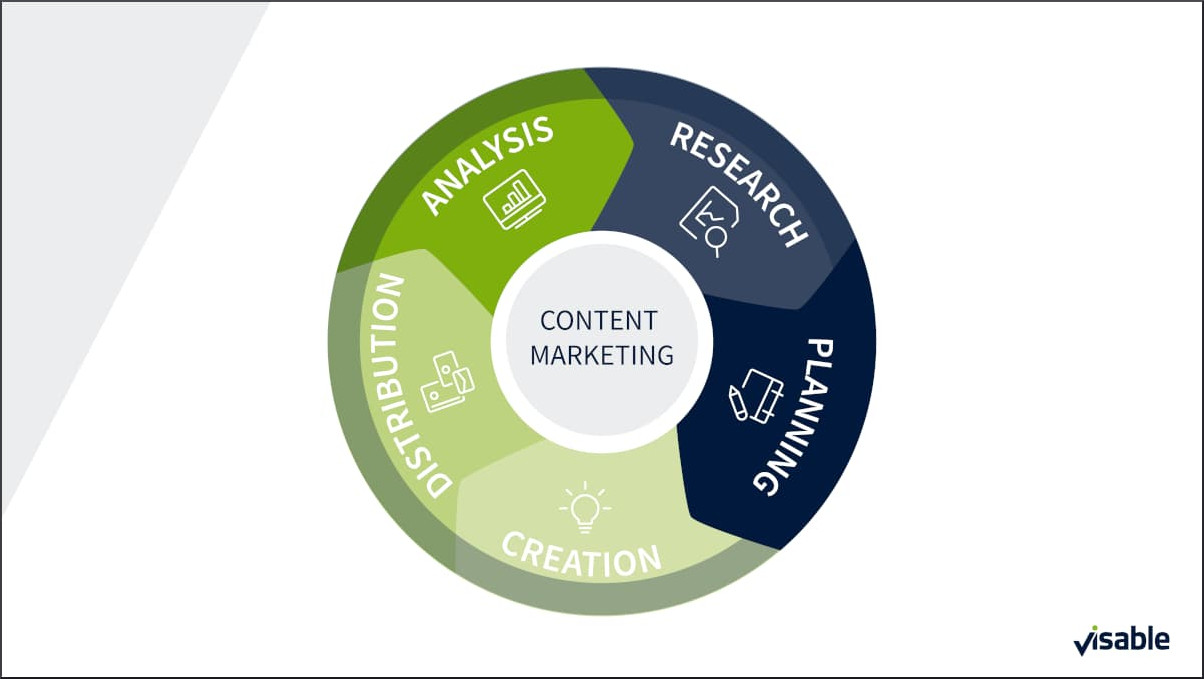Content marketing is one of the top B2B marketing trend in 2021. But without a good strategy, all efforts will be in vain. What counts most, which goals can be achieved with the right content and how this trend is developing – read about it all here.

Content marketing: definition and meaning
Content marketing is a marketing method which provides relevant content on various channels for a certain target group. Using this content, the company aims to bring attention to its offers, to win over new customers and to foster loyalty amongst existing customers.
The fact that high-quality and useful content is becoming ever more important can be seen in the latest industry survey by Vogel Communications Group, taken among 600 marketing experts and decision-makers from the most significant industrial sectors. For nearly 82 per cent, content marketing is one of the top B2B marketing trends in the year 2020. In fact this trend is so popular that it continues to be an essential element in the marketing mix for 2021 too.
To put this in perspective: marketing automation is in second place; however, this trend was named by only about 48 per cent of those questioned. But what these findings also show is that a lack of relevance of the content published does not seem to have any effect on the business.

Achieve these goals with content marketing for B2B
Like every marketing measure, content marketing should ultimately contribute to increased sales. The secondary individual goals which companies want to achieve with their content marketing strategies can be seen in the Content Marketing Trend Survey 2019 from the Statista statistics portal. Nearly two-thirds of those companies questioned are from the B2B segment.
- Boosting brand and company awareness (81 per cent of companies surveyed)
- Winning new customers (69 per cent)
- Establishing customer loyalty (65 per cent)
- Generating leads and creating occasions for talks (56 per cent)
- Boosting sales with consistent conversions of interested persons into customers along the customer journey (49 per cent)
- Recruiting and employer branding (22 per cent)
- Improving corporate communication (18 per cent)
B2B content marketing strategy
A strategic concept is essential for performing successful content marketing. The planning process can be broken down into three steps:
- Definition of the current situation: Which target group does your company want to address? Who are the competitors? How tough is the competition on the market? Afterwards, the areas are defined which can be improved and the goals to focus on are determined.
- Creation of an editorial plan: Such a plan defines the forms of content and the channels on which the content should be distributed. Whether existing content in the form of text, pictures or videos should be optimised and adapted to the respective channel, or if new content should be generated. What’s more, a research of topics should show which content pieces should be communicated in which way.
- Analysis of measures: Based on the essential figures and reports, the success of the campaign is monitored and the strategy for further steps is optimised.
Recommended content formats for B2B
The planning of content is the focus of every content marketing campaign. Particularly for B2B, content marketing should offer true added value. The following formats can be considered:
- Blog articles
- White papers
- E-books
- Info graphics
- Case studies
- Webinars
- Videos
- Podcasts
A blog offers the chance, for example, to regularly and thoroughly handle specialist topics. A total of 82 per cent of those B2B companies questioned in the trend survey leverage special interest articles to reach their target group. E-books and white papers are also promising content formats for B2B, as they often can hand complex topics very well.
Hygiene, Hub, Hero Model: plan content on a program level
Providing guidance for the planning and creation of content is the Hygiene, Hub, Hero Model. This model is similar to a pyramid consisting of various types of content. It was originally developed by Google specially for video content; however, it can be applied to all other formats as well.
- The foundation is formed by Hygiene content, often also coined Help content. This SEO-relevant content is based first and foremost on search requests by the target group and helps to deliver answers to their requests. The typical guide format falls into this category, as well as explanatory videos or tutorials. This so-called pull content is the basis of content planning and serves mainly to generate visibility in the search results. Hygiene content can also be user-generated, for instance in the form of reviews or product explanations.
- Content on the Hub level aims to animate the user to regularly return to the company’s website or the corporate blog, or it inspires the user to follow the company on social networks. Hub content also ensures the interest the target group has already gained is not lost. Also known as push content, this content is broadcasted less frequently and offers relevant added value that supports the user in a most subtle way on their journey through the Internet or which motivates the user to interact. White papers available for downloading are a popular example of this for B2B, as a way to handle essential topics in more detail.
- At the tip of the content pyramid is Hero content. This term encompasses elaborate productions, whereby the sole user value is secondary. This content grabs attention first and foremost, contributing to the building up of the brand and communicating to the target group in an often entertaining and emotional way. Hero content can be exclusive interviews, for example, costly video productions or surveys which are picked up by the media due to their relevance or shared on social networks.
All in all: without Help, no Hub; and without Hub, no Hero. Solid Help content is compulsory; Hub and, above all, Hero content elective.
Seven B2B content marketing trends
Like nearly all marketing disciplines, content marketing is also continually developing further. B2B companies should keep an eye on these seven trends:
1. Video content
A total of 62 per cent of those companies questioned in the trend survey have had a good experience with visual content such as informative graphics and animated videos. Whether explanatory videos, webinars or even augmented reality formats, moving content is in great demand. Image films are already a highly popular measure in the content marketing mix.
2. Podcasts
In the entertainment and information sectors, podcasts have long played a part in the consumer world. However, in 2020, only ahandful of formats in the B2B segment have grabbed people's attention. Despite this, podcasts are an ideal format for communicating complicated content. Especially when it comes to B2B, where niche topics are often relevant, this audio format could allow for a successful closure of the customer journey, as it builds trust and boosts credibility.
3. Lead generation
The boosting of awareness and reach are two essential goals of content marketing in B2B; however, they are increasingly stepping aside for lead generation. Companies are noticing more and more that high visibility and more customer contact alone are not effective enough if not those people are being reaching who have the will and purchasing power to close a deal.
4. Quality first
High-quality content will become even more important in future than it already is today. Companies which have built up trust among their target group thanks to proven expertise based on special interest articles or studies will be considered to an even higher degree in Google’s search results.
5. Storytelling
Even if factual information is important for B2B, the trend is going towards content marketing campaigns which communicate emotionally with the target group. After all, companies are becoming more and more aware of the fact that real people are taking decisions in the area of business. With storytelling, facts can be packaged in a story that can be consumed in a much more appealing way.
6. Credible facts
Whenever facts, data and numbers are given, they should include a link to the source to be proven with other references. On top of this, the source should be from a serious publisher. If an own in-house survey is used to visualise information, it shoud clearly state how the data was collected. The reliability and truthfulness of information is more essential than ever in content marketing in 2021, as readers are viewing data with increasing scepticism in times of fake news and fals information.
7. Personalised content
How you address the recipient, as well as present the content, is becoming increasingly tailored to individual target groups. Digital technologies are helping to establish personalised communication in B2B too. Offers ca be specifically designed and precisely tuned to the situation and the needs as well as the position of the potential customer along their customer journey.
Conclusion: B2B marketing is an all-rounder
B2b content marketing increases the awareness of brands and companies, as well as their products or services. It is suitable for both the acquisition of new customers and the binding of existing customers. Relevant content initially brings attention to the author and his or her company, thus piquing the interest of the desired target group. Once a format has become established, it communicates content as an authority in the individual specialist field and builds trust in the expertise of the company responsible for the content. If you base your content marketing on a strategy, follow the latest trends and leverage the discipline in the marketing mix together with other disciplines such as performance marketing, SEO, PR and email marketing, you will be able to achieve your goals over the long run.
